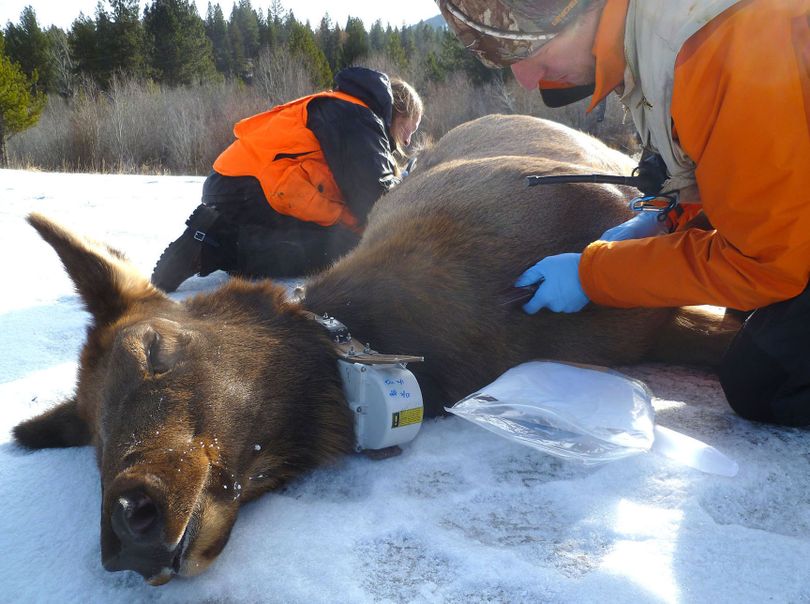Despite elk-loss research, Montana hunters protest increased quota on cougars

HUNTING -- Here's an interesting twist to the turmoil about predators and their impact on Montana elk populations.
Even though research has indicated that mountain lions kill way more elk than suspected in the Bitterroot Mountains -- way more than wolves -- there's opposition to reducing the cougar population, and it's coming from mountain lion hunters.
Borthwestern Montana cougar hunters roundly criticized Fish, Wildlife and Parks’ proposed lion quotas for the next two seasons at the Fish and Wildlife Commission meeting in Helena last week, reports Brett French, outdoor writer for the Billings Gazette.
Read on for the details in the rest of French's story.
Under the proposed changes, lion quotas would be raised in 37 hunting districts and all of Region 7 in southeastern Montana allowing an additional 37 lions to be killed. In only two hunting districts, HD 121 and 122 in northwestern Montana, would the quota be reduced by four.
The commission approved the creation of a study group to examine the idea of combining the six Region 2 hunting districts into one lion hunting license area with the number of licenses issued equal to twice the quota of the six districts. The group should have a recommendation to the commission by June. Quotas for lions in Region 2 would remain at 2013 levels.
The hunters specifically denounced FWP’s lion population estimates in the Bitterroot Valley as being too high. The area has been under scrutiny because of declining elk populations blamed on a predator-rich environment that includes mountain lions, bears and wolves.
A recent FWP study showed mountain lions killing more collared elk calves than the other predators combined, so this past season the second half of the lion hunt was opened to anyone with a lion tag, as opposed to limiting it to only those with a permit to hunt those specific hunting districts in the Bitterroot. The lion quota was also increased in the area.
The result was a large influx of hunters from outside the region and the killing of young lions simply to satisfy outfitted clients, Bitterroot lion hunters charged. The additional hunting pressure was unwarranted, they said, because there are few of the big cats left.
“They’re not there,” said Chuck Pyles, who lives along the West Fork of the Bitterroot River. “I hunt almost every day and they’re not there. I would like to see you lay off the females, lower the quota, because if not, we’re going to have a problem.”
Veteran hunter Grover Hedrick said he drove 132 miles of roads and only found five adult lion tracks in the Bitterroot.
“That’s not very many,” he said.
The FWP study that estimated lion numbers for the region was criticized as deficient on many fronts by the hunters.
“What we got was keyboard cougars and paper pumas,” said Rod Bullis.
Retired Washington Department of Fish and Wildlife research scientist Gary Koehler called the baseline population a best guess in a study that couldn’t be replicated for verification.
“This is a dangerous extrapolation from an untested protocol,” he said.
He said that work the study cited in Washington utilizing DNA samples is still being peer reviewed and tested.
“I’m concerned about using DNA … that may set a dangerous precedent for other wildlife agencies,” Koehler said.
Fish and Wildlife Commission chairman Dan Vermillion said the lion controversy, which has dragged on for decades, is “one of the most vexing issues I’ve faced.”
“Today’s comment period raised more questions for me than it answered, said Commissioner Matt Tourtlotte, of Billings. “For me, we’ve got a report that says the lion population is more than” what lion hunters are seeing.
He said the commission is essentially being asked to consider two very different sets of numbers, both of which are vague.
FWP Wildlife Bureau chief Quentin Kujala said the agency’s population study is undergoing peer review, which could provide more clarity for the commission.
“It’s a vexing issue,” Tourtlotte said. “I fear I’ll hear about it every year I’m on the commission. I just think it’s a mess. It seemed like we were taking a step in the right direction but we’re bogged down in the mud.”
